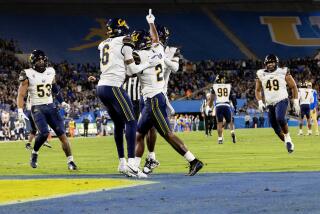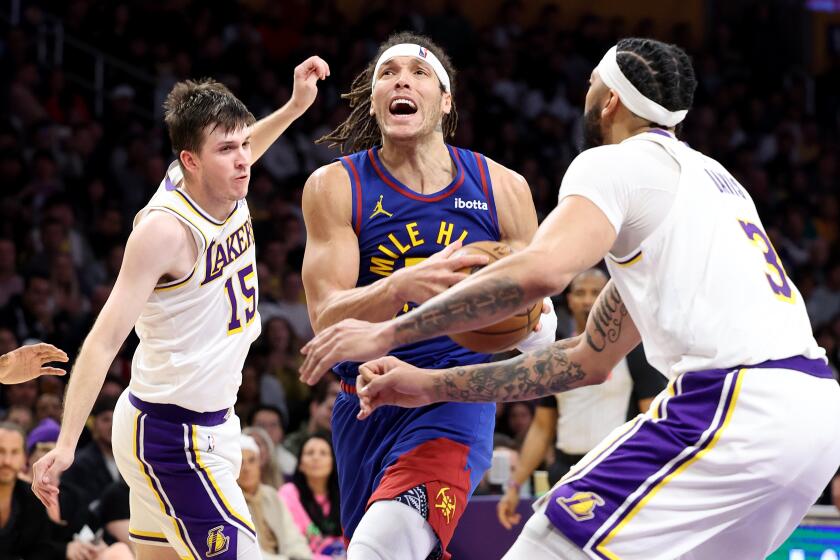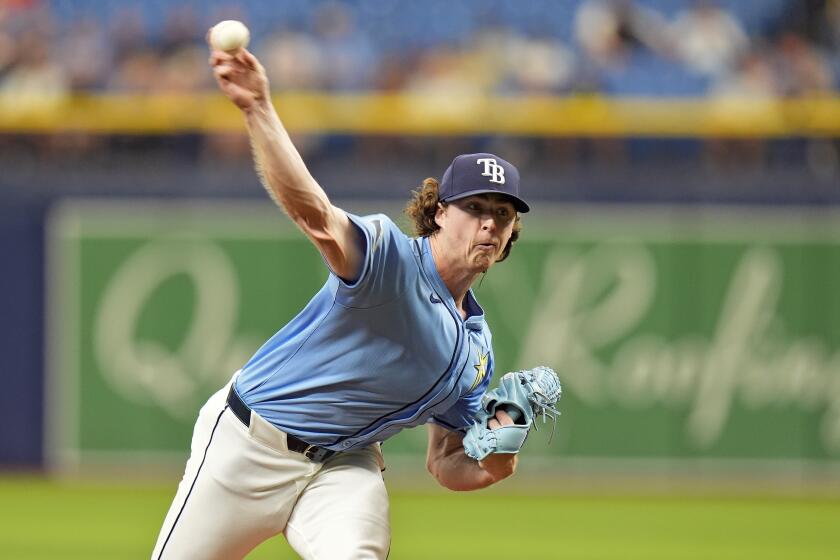Column: College sports’ billion-dollar issue: Who pays freight on pay-to-play?

NCAA President Mark Emmert has called a move by college football players at Northwestern to unionize “ridiculous,” but acknowledged the potential implications would be “profound, to say the least.”
The commissioner of one college conference recently compared the state of the NCAA to that of a delicate ecosystem being threatened by the heat of what is shaping up to be a long and litigious summer.
Ed O’Bannon’s lawsuit against the NCAA, set for trial this month, is one issue. The former UCLA basketball All-American is leading a class-action complaint that challenges the NCAA’s right to use the images of former players for commercial purposes. Billions of dollars are at stake, and a favorable outcome for the plaintiffs could radically alter college athletics.
Another is the vote of Northwestern football players to unionize, an idea NCAA President Mark Emmert termed “ridiculous” before acknowledging the potential implications were “profound, to say the least.”
In both instances, it could take years for the cases to be adjudicated. Which is why athletic administrators from across the country for now are focused on a different, more pressing topic: A stipend for athletes that would cover the full cost of college attendance — the difference between what a full athletic scholarship costs and what it actually costs to attend a particular university, as determined by federal guidelines.
The nation’s biggest and most influential college sports programs — 64 schools from the “Big Five” conferences, plus Notre Dame — are willing and able to fund the extra payment by dipping into the windfall created by television mega-deals for football and basketball.
The stipend, they believe, should at least partially pacify critics who contend the NCAA is getting rich on the backs of college athletes who in some cases are living poor.
A similar solution was floated before but was stymied by the smaller, less-affluent schools that comprise the vast majority of the 351 that compete at the NCAA Division I level. Those universities don’t have athletic programs that turn a profit, and they are concerned that the already significant chasm between the haves and have-nots is about to grow.
The difference this time is that power schools are using the threat of secession to get their way.
“If we didn’t help those guys out, the thought of them breaking off and doing their own thing was probably very viable,” said Dennis Farrell, commissioner of the Big West Conference.
The Big West is among the 22 conferences that don’t play major-level football, and whose schools have essentially been brought to their knees.
In the Greater Los Angeles area there are 10 universities with Division I sports programs — a cross section of schools private and public, big and small. USC and UCLA are the football juggernauts from the Pac-12 Conference. The others — Cal State Fullerton, Cal State Northridge, Long Beach State, UC Irvine, UC Santa Barbara and UC Riverside of the Big West; Pepperdine and Loyola Marymount of the West Coast Conference — don’t field football teams.
In August, the NCAA Board of Directors is expected to consider, and pass, full-cost-of-attendance legislation. What happens after that has athletic directors around the country on edge.
Asked what worried him most, Loyola Marymount Athletic Director William Husak replied, “I don’t know where to quite begin.”
Said Steve Potts of Pepperdine: “What is it going to look like? That’s what I want to know.”
The stipend for a particular university would be determined by the school, not its athletic program. One recent survey estimated the payments might range from $1,000 to $6,904 per year, depending on the school and related variables. When a stipend was proposed before, it was for $2,000 per athlete, regardless of the school.
The athletic programs from the power conferences have the financial resources to raise the stakes. Schools from the Pac-12, for example, benefit from a recently signed $3-billion television deal with ESPN and Fox.
Those schools also know that providing an additional stipend — which universities from other leagues might not be able to afford — strengthens their competitive stranglehold.
Offering an athlete an educational scholarship, which at some schools is worth in excess of $200,000 over four years, once seemed a reasonable trade for the services of student-athletes. But that deal doesn’t seem as good in an age when universities from cash-cow football conferences are paying coaches as much as $7 million a year.
Larry Scott, the Pac-12 commissioner who negotiated the league’s lucrative network deal, was paid an estimated $3 million last year.
The NCAA has mostly itself to blame for a disparity in college sports that has grown steadily in the last three decades. Its tightfisted control of football broadcasting rights led to a landmark antitrust loss in a 1984 Supreme Court case brought by Oklahoma and Georgia.
The decision allowed individual conferences to negotiate their own television rights, and network money was soon flowing to the conferences with brand-name schools: USC and UCLA of the Pac-12, Alabama and Florida of the SEC, Ohio State and Michigan of the Big Ten, and Oklahoma and Texas of the Big 12. Notre Dame signed its own deal with NBC.
“It went from socialism to unabated capitalism,” said Farrell, the Big West commissioner. “And if I’m in their shoes, I’d probably be doing the same thing.”
The athletic directors of USC and UCLA are, first and foremost, paid to act in the best interests of their schools. Offering a full-cost stipend is in their best interests.
“I think the NCAA is looking at a lot of things they can do immediately, and this is one of them,” said Steve Lopes, chief operating officer and chief financial officer of USC’s athletic department. “We’ve been big advocates and will do as much as we possibly can for our student-athletes.”
With full cost of attendance about to become reality, smaller schools are scrambling to determine where they stand in the latest phase of intercollegiate Darwinism.
In five years, it is estimated each Pac-12 school will receive more than $30 million annually in television revenue. Meanwhile, Big West schools receive annual payments estimated to be in the low six figures.
UCLA, UC Irvine and UC Riverside, partners in the same California educational system, are strangers when it comes to athletic finances. UCLA’s annual athletic budget for 2012 was $71.7 million compared to $15.3 million for UC Irvine, according to a USA Today survey. Then consider the difference between Texas ($163.2 million) and UC Riverside ($14.6 million).
“We’re not going to be able to keep up with the Smiths and Joneses,” Riverside Athletic Director Jim Wooldridge said. “That’s reality.”
It is likely that all schools would be allowed to implement the full-cost stipend, but that doesn’t mean all will.
“How will we pay for it?” asked Potts, Pepperdine’s AD. “It will have to be reallocated from somewhere else in the budget.”
Said Husak of Loyola Marymount: “It’s not like we have loose change hanging around.”
Other questions: Will the stipend cover athletes in all sports? What about those on partial scholarships? And what about Title IX, the landmark federal decision that demands equality for female athletes?
“The devil is in the details,” said Dan Guerrero, UCLA’s athletic director.
Lopes guessed that USC athletes on partial scholarships would receive a prorated stipend paid out over nine months. For example, a baseball player receiving a 25% scholarship would receive a quarter-share of the full-cost stipend.
Administrators at non-football-playing schools have vowed to find the resources to financially help their athletes. But what some fear, more than full cost of attendance, is what the power conferences plan to do next.
“They might eventually get everything they want,” Potts said. “But will that satisfy them?”
One concern is that the largest programs might use their financial advantage to change the scholarship paradigm.
Southland schools that don’t play football often successfully compete with USC and UCLA in non-revenue sports. Cal State Fullerton has won four NCAA titles in baseball, and other area schools can stand toe-to-toe with the Pac-12 in sports such as volleyball, water polo and golf.
That would change if, for example, UCLA suddenly decided to increase its baseball scholarships from the NCAA-capped 11.7 to 16, or 20.
Potts said that could put Pepperdine baseball out of business.
Farrell of the Big West said the scholarship issue is “our line in the sand.” And that’s when he used a few ecosystem metaphors. “You don’t necessarily want to kill off the plankton, or else you kill off the whales,” he said.
Guerrero, who was Irvine’s athletic director before being hired away by UCLA, said he understands the concerns and can’t envision the Big Five programs damaging their relationship with non-football schools.
He said Pepperdine and Irvine must continue to compete with UCLA and USC in the non-revenue sports. “Access to championships should be an absolute,” Guerrero said. “Those things should remain sacred, if you will. I get that.”
Guerrero said UCLA would continue to support the NCAA cap on scholarship limits. He said the issue should be “untouchable.”
It seems unlikely the Big Five leagues would make the predatory leap past full cost of attendance. The likes of UCLA and USC need an inventory of teams to fill their schedules in sports other than football and basketball.
However, some of the power leagues have already proven they are prone to act independently, and selfishly.
One example: Football leaders agreed in principle to play nine-game league schedules as part of the new four-team College Football Playoff. Then Southeastern and Atlantic Coast conferences decided to stay at eight.
“What’s interesting is whether the Five can agree to do anything,” Farrell said.
Not everyone thinks this is going to end well. Boise State President Bob Kustra, whose school is a member of the second-tier Mountain West Conference, recently blasted the Big Five reform plan.
He said the power conferences won’t stop until they have it all.
“I have no doubt that the Big Ten and the SEC are designing these reforms to try to leave some people behind,” Kustra told the Idaho Statesman. “This is about leaving the Boise States behind and making sure the Alabamas and Tennessees and whoever they are can march right along.”
Several important issues take center stage this summer, but some say this is only the beginning of a reform fight.
“This is Round 1, or 2,” said Wooldridge, UC Riverside’s AD. “There will be more.”
More to Read
Get our high school sports newsletter
Prep Rally is devoted to the SoCal high school sports experience, bringing you scores, stories and a behind-the-scenes look at what makes prep sports so popular.
You may occasionally receive promotional content from the Los Angeles Times.







